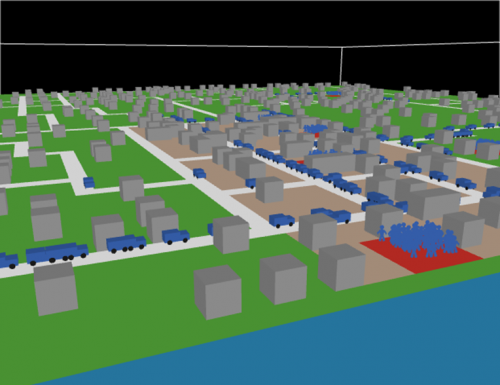Too much of a good thing for Aberdeen? Lessons from an agent-based model of commuting.
Posted by Jiaqi Ge on Thursday 19 July 2018
Imagine a new policy that allows you to work anywhere at any of the workplaces in your region. Where do you choose to work?
Now, think about everyone else who has the same right to work where they choose. Will you change your answer to the first question?
Often, well-intentioned national, regional, or organisational policies can lead to undesirable and unintended consequences because they almost naively assume that the aggregated effect is simply the sum of the individual effects. Theories of complex systems show that the whole is rarely best understood as the simple sum of the parts, far from it.

We developed an agent-based model, which is a research method that simulates interacting, heterogeneous individual agents in a computational environment (Netlogo in this case) to study emergent patterns and complex aggregated results. We found that the apparently attractive ‘win-win’ policies of workplace sharing can be negated by unseen factors such as informal working practices. The aggregated systemic effect is highly context sensitive, and nothing like as clear-cut as suggested by the effect on one individual. We can indeed have too much of a good thing! In a recent paper, we find that the apparent benefits of workplace sharing for commuting times and CO2 emissions from transport can be negated by organizational structure and corporate culture. Informal policies whereby team leaders stipulate collocation of team members to facilitate day-to-day and face-to-face interaction can even lead to a worse situation than the case where there is no workplace sharing. The effect of the workplace sharing programmes also depends on the spatial distribution of existing road network, as well as industrial and residential areas.
In an earlier study in 2016, we used an agent-based model to explore the combined effect of factors influencing commuting patterns and CO2 emissions in Aberdeen. Again, we found that unexpected systemic effects emerge from individual interactions. For example, we found that flexi-time (a flexible range of times at which you can arrive at work) not only reduces commute time significantly, but also makes the time spent commuting more reliable and reduces CO2 emissions from traffic. In comparison, a new bypass will only reduce mean commuting time by a small amount, while slightly increasing total CO2 emissions.
Sometimes, policy solutions that make perfect sense at first sight can lead to unintended consequences, because although people make decisions independently, the effects of those decisions are played out in a shared space. The world is a complex place with everyone and everything connecting and interacting with each other.
Often, the emergent results from a large number of complex interactions are almost impossible to derive using a “paper and pen” method. Agent-based computational modelling thus provides an alternative approach. The James Hutton Institute is among the first places in the UK to develop agent-based models for social and economic systems. At the James Hutton Institute, we benefit enormously from working as an interdisciplinary team, which includes computer scientists, psychologists, economists, and sociologists. Many of our projects feature close collaborations between groups, especially between the Information & Computational Sciences and Social, Economic and Geographical Sciences groups. As computing power increases rapidly every year, we believe the potential and demand for agent-based models will continue to grow.

Image: Screenshot of ABM to measure impacts from commuting parterns around Aberdeen
Want to find out more about our methodology and results? We have published two papers regarding transport simulation and policy:
Paper on workplace sharing programmes: https://www.sciencedirect.com/science/article/pii/S0966692317303356
Paper comparing flexi-time and road construction to reduce congestion in peak hours (open access): http://jasss.soc.surrey.ac.uk/19/3/11.html
I would like to thank Gary Polhill and Tony Craig for their valuable input, both are co-authors of the works mentioned in this blogpost.






Comments
Post new comment